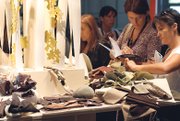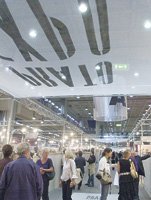Third Season of Milano Unica Brings European Crowd, Some U.S. Cos.
MILAN—The third season of Milano Unica, the large European textile trade show, drew a crowd of European attendees, as well as a smattering of American buyers.
This year’s show, held Sept. 12–15, returned to the Fieromilanocity after one season at the less-central Rho-Pero fairgrounds.
“We are happy to come back to this venue because it is so close to Milan,” said Paolo Zegna, president of Milano Unica, through an interpreter at an opening-day press conference.
Milano Unica was created last year when four existing Italian textile shows joined forces: Moda In, Ideabiella, Ideacomo and Shirt Avenue. Last season, Prato Expo joined the lineup in Milan.
Its organizers hoped that hosting the shows at the same time under one roof would make it easier for buyers to attend and shop multiple shows.
For many, that proved to be the case.
Los Angeles designer Christian Weber was at the show preparing for the launch of his new line, CW Christian Weber, set to bow for Fall/Winter 2007 (see related story on page 9). Weber, who was most recently with Los Angeles–based Rock & Republic, previously worked for Versace and is very familiar with the Italian market and the five shows that make up Milano Unica. Weber will be manufacturing most of his collection in Italy and had devoted a week to working in this Mediterranean country.
“We found a great selection here, especially since they put them all under one roof,” he said. “It makes working much easier, and since we are producing here [in Italy], we can work directly with the manufacturers.”
Weber said that with the textile shows combined, apparel manufacturers could save time and money on travel and the savings could be put into spending more time at Milano Unica.
In Moda In, French shirting maker Trouillet saw some crossover buying from Shirt Avenue attendees, said its representative, Yvon Champalle. The company has been a longtime Moda In exhibitor but also had exhibited at Shirt Avenue in past seasons. “The thing that helped me is that I kept my Shirt Avenue customers,” he said.
Although Trouillet’s collection is more casual than many at Shirt Avenue, Champalle said he was seeing some buyers looking for more casual items to add to their lines. “We’ve seen more people orientated to Shirt Avenue,” he said.
Still, there were some impediments to cross buying. Ideabiella, which represents several high-end menswear mills from the Biella region, required visitors to have a separate admission badge.
There was quite a lot of ground to cover. Fieromilanocity is more compact than Rho-Pero; nonetheless, the show covered more than 92,000 square feet of exhibition space on two floors of the convention center, with more than 700 exhibitors showing, about the same number as at the last Milano Unica show in February.
This season’s run featured 35,544 attendees, representing an 18 percent growth over last season, when more than 30,000 visitors walked the show.
The show drew 921 American attendees, a 30 percent increase from February. Milano Unica this season fell during New York Fashion Week and as Italian designers were preparing for their own Milan Fashion Week, set for Sept. 23–Oct. 1. Those two events may have kept some attendees from visiting the show. However, the pending textile show Premiegrave;re Vision in Paris may have had the biggest impact on attendance—at least for many California brands.
In addition to Weber, several exhibitors at Milano Unica reported meeting with Juicy Couture, the Los Angeles division of New York–based Liz Claiborne. Others said they had booked appointments with California companies such as BCBG Max Azria, Bebe, Arden B., Twelfth Street by Cynthia Vincent and Trina Turk for Premiegrave;re Vision, Sept. 19–22.
Although a few textile firms skipped Milano Unica in favor of Premiegrave;re Vision, most were exhibiting at both shows.
That was the case for Studio Bert Forma owners Kevin and Heather Maldonado, who were planning to continue on to Paris after Milan. The Maldonados purchased the Los Angeles–based company two years ago and recently opened a New York office. Currently, they represent 22 European textile lines. The husband-and-wife team was in Milan with its Luigi Botta line, which showed at Ideabiella. The mill, which produces the high-end Fila line, contemporary collection Gartex and more moderate men’s and women’s line Luigi Botta, recently restructured its business with an eye to tightening production from 90 days to 60 days. The company sells to such California labels as St. John and Vince, as well as large private-label makers such as Nordstrom.
European business
“This show coincides with New York Fashion Week, so we’ll see the bulk of our people at PV,” said Cristina Knaus, president of New York–based Grupo Textil, which had two companies at Milano Unica: French lace mill Sophie Hallette at Moda In and Marco Lagatolla at Ideacomo. Knaus said she was seeing mostly European buyers in Milan, although a handful from Canada and from New York turned out as well.
In addition to Italian buyers, Seterie Argenti’s Michele Viganoacute; met with Eastern European buyers, including representatives from companies in Russia, Poland and Slovenia. By day two of the show, he had met with only one U.S. company, Juicy Couture.
But most of his California customers, including Bebe, BCBG and Guess were scheduled to meet with him in Paris, as well as smaller labels such as Samora and Jasmin Shokrian. “We always have good people from L.A. in Paris,” Viganoacute; said.
Traffic was slow on opening day at the Efilan booth in Prato Expo, said its representative, Giovanni Bruni. After Milano Unica, the company was going on to Paris to show at Premiegrave;re Vision for the first time. “Usually when Prato Expo was in Florence, we had a lot of business,” Bruni said. “Now, in Milan, we have less. Maybe Paris is better.”
Traffic was heavier next door at the Picchi booth, where its representative, Fred Rottman, said he had seen just a few customers from the United States, including the ubiquitous Juicy Couture. “The combined show? So far the jury is still out as far as the American customer,” he said.
Picchi was a longtime Prato Expo exhibitor, and despite joining Milano Unica, “we’re still segregated,” Rottman said.
Buyer traffic might be improved if the five shows were not held in separate halls at Fieromilanocity, he said. “It’s not like they can just drift over, [as they could] if we were on the same floor.”
At Shirt Avenue, Italo Lazzari, owner of textile company MTVV, as well as retail chain Lazzari, said he thought the show could benefit from more merchandising and more specialization. For example, it could have sections for denim, wovens and better collections, as well as ones for washing and finishing, Lazzari said.
And he suggested that the show be held just once a year. “One fair per year with all the different sections,” he said. “This system is 30, 40 years old. It’s nice to change.”
However, it’s unlikely Milano Unica will expand beyond textiles, according to show organizers.
“We are a textile trade fair. It’s something different from other types of finished products,” Zegna said through an interpreter. “We do not want to invite raw materials. Today, we try to strengthen the products [we have], instead of diluting the message we have defined so clearly.”
The next edition of Milano Unica is scheduled for February and will likely be held again at Fieromilanocity. For more information, visit www.fieramilano.it.
Los Angeles via Italy
MILAN—Designer Christian Weber is looking to bridge the gap between Italian quality and Los Angeles creativity with his new collection, CW Christian Weber, set to launch for Fall/Winter 2007.
The women’s line will occupy a place and a price point somewhere between contemporary and designer, which Weber is calling “Premium Luxury.” Indeed, the designer says the contemporary market has become diluted, no longer setting trends but following them.
Weber describes his customer as young, sophisticated and looking for body-conscious, yet professional clothing that is more of an investment in her wardrobe. “She wouldn’t buy something she can wear for just one season,” he said. “She wants something she can wear for the future.”
As an example, Weber describes a young attorney who wears premium denim on the weekends but needs something more professional for work. “We’re trying to add a new type of product, dressing the successful woman who can’t wear premium denim in court but wants something that looks just as sexy,” he said.
The collection will launch as a total look, including suits, belts, bags and “a denim pant or two,” said Weber, who was most recently with Los Angeles–based Rock & Republic. He developed his knowledge of the Italian market as a designer for Versace.
Weber’s backers have business connections in Asia, which will allow the designer to open his first flagship store in Seoul, South Korea, in June.
Although most of the collection will be produced in Italy, all jersey items will be produced in Los Angeles. “That’s the core competency in L.A.,” Weber explained.
But the design—and the inspirations—will come from Los Angeles. “L.A. is such a hot spot,” he said. “I worked for many years for Versace and thought, why not build a design office in L.A. with production in Italy and combine the old world with the new?”























